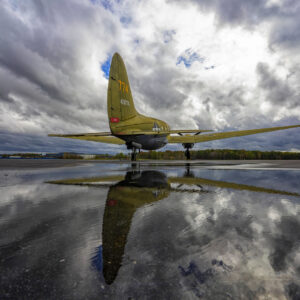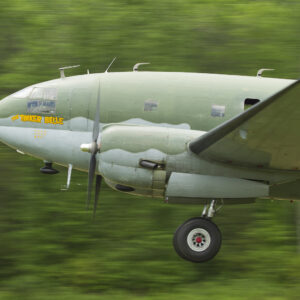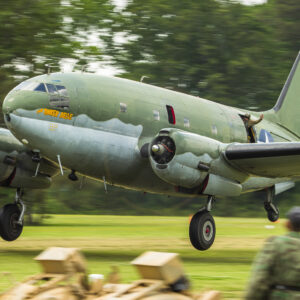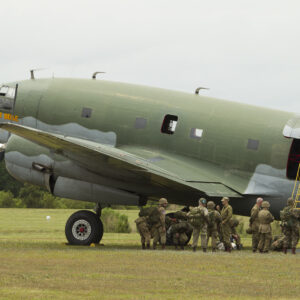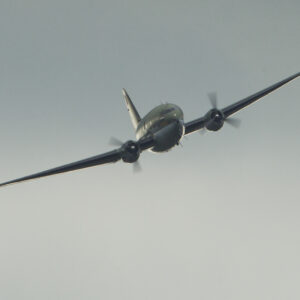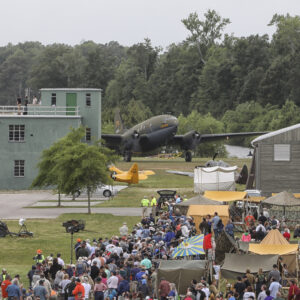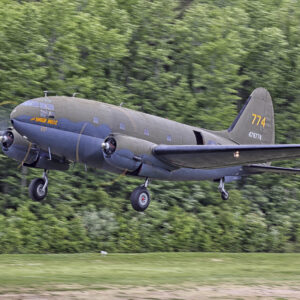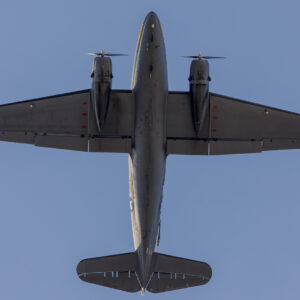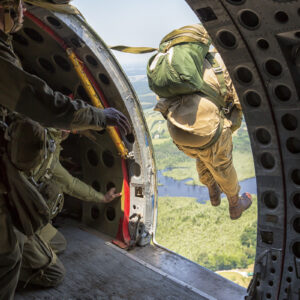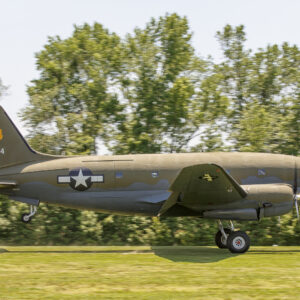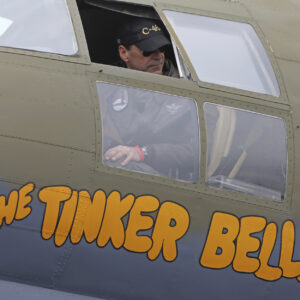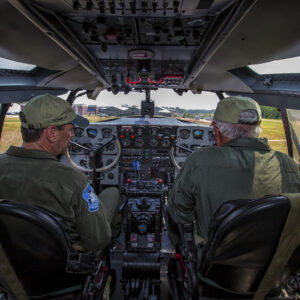The Curtiss C-46 was an unsung hero of WWII. It served in every theatre of the conflict, connecting far-flung garrisons across the globe as part of Air Transport Command. It also played a crucial role in keeping China in the war at a time when Japan had severed all other supply routes into that nation.
The Whale
The first thing you notice when you walk up to the Museum’s C-46 is just how enormous the aircraft is! The Commando is longer than a B-17 Flying Fortress heavy bomber and has a greater wingspan too. What’s more, it stands so tall on the Museum’s ramp that visitors in the second story viewing gallery will have to look up to see into the cockpit windows! The aircraft was the largest, twin-engined transport in the world when it first flew in March, 1940. It is no surprise, therefore, that U.S. Army Air Forces pilots often referred to the C-46 affectionately as the Whale.
From Airliner to Military Transport
The Commando evolved from the Curtiss CW-20, a then-revolutionary pressurized passenger plane, designed in 1937 to compete with other advanced airliners of the day, such as Boeing’s Model 307 Stratoliner (to which it bears an uncanny, albeit superficial resemblance). The CW-20 prototype, built at the Curtiss factory in St.Louis, Missouri, first flew in March, 1940. The U.S. Army Air Forces (USAAF), interested in the type for its potential as a cargo plane, commissioned Curtiss to build a variant for the service. Forgoing a prototype phase, the USAAF ordered 25 C-46-CUs and 21 C-46A-1-CU airframes in September, 1940. The C-46A (CW-20B) involved significant design changes over the basic C-46 (CW-20A) design such as a strengthened floor, the addition of a large cargo door, hydraulic cargo winch, more powerful Pratt & Whitney R-2800 engines and the deletion of pressurization equipment. Interestingly, to gain experience with the design before receiving their first C-46s, the USAAF purchased the CW-20A prototype in June 1941, designating it as a C-55 with the serial number 41-21041.
Commandos Join the USAAF
The USAAF received their first handful of C-46A Commandos just before the attack on Pearl Harbor in December, 1941. The type formally entered service in May of 1942, but it took time for sufficient numbers to become available due to the numerous modifications required; it was a complex and maintenance-heavy aircraft for its day.
Flying The Hump
The Curtiss C-46 played a major, though oft-forgotten role in defeating Imperial Japan during WWII. The aircraft’s unique cargo-carrying capabilities and performance helped keep China in the war at a time when its collapse seemed imminent. China had been fighting Japan since September 1931, following the latter nation’s invasion of neighboring Manchuria. By the spring of 1942, Japan had successfully cut off China’s remaining overland supply routes and either captured or blockaded the coast. Establishing an air bridge from India remained the only viable option for getting desperately needed war materiel into China. But this involved a long and perilous journey flying cargo over, around or through the world’s tallest mountain range, the Himalayas, often referred to colloquially as ‘the Hump’. Pilots in their overladen aircraft frequently encountered atrocious weather conditions enroute, with winds exceeding 125mph and rapid deterioration of visibility. Opportunities for flying into a so-called ‘granite cloud’ presented themselves regularly, with the route over the Hump sometimes referred to as the Aluminum Trail, due to the number of crashed aircraft marking the way.
The first Commandos arrived for service over the Hump in April, 1943. Of all the cargo types then on hand – the C-47, C-54, C-87 and C-109 being chief among them – it was the C-46 which proved to be by far the most effective in this specific role. The aircraft’s cavernous hull and powerful R-2800 engines gave it a significant edge over its contemporaries, allowing it to fly higher and with greater loads in highly adverse conditions. Describing its suitability for this task, the Army Air Forces C-46 Pilot Training Manual notes: “Day in, day out, [in] good weather and bad, Commandos are delivering the goods over the Hump – the roughest, toughest 600 miles of airway in the world.”
Other Duties
In addition to flying war materiel to China over the Hump, several C-46 squadrons were attached to XX Bomber Command, supporting the B-29 Superfortress units involved with Operation MATTERHORN – the bombing of Imperial Japanese forces in China and Southeast Asia, along with the industrial base in the Japanese home islands. The 400 or so B-29s involved in MATTERHORN flew from airfields in both India and China, but they needed an enormous supply of fuel, spare parts, replacement engines and munitions, which Commandos provided, flying a long, circuitous route from North Africa.
The United States Marine Corps also made great use of the Commando’s capacious cargo capacity in their island-hopping campaign across the Pacific Ocean, operating 160 examples as the R5C-1 (C-46A).
C-46 Commandos also played a significant role in the European Theatre towards the end of WWII, dropping paratroopers and supplies during Operation VARSITY, the largest, single-day airborne operation in history, which saw the Allies successfully cross the Rhine River into the German heartland.
The Tinker Belle
Curtiss built our Commando at their factory in Buffalo, New York, the birthplace of all but a handful of the type; ours is a C-46F, the final production variant (234 examples) of the breed. While, we have little information at present regarding the airframe’s military history, we do know that Curtiss delivered it to the USAAF as serial number 44-78774 in September, 1945. Given that the war was over at that point, it likely went into storage for a while. Three years later, almost to the day, Pan American World Airways leased the C-46 from the newly-renamed U.S. Air Force, placing it on the civil registry as N74178. The airline operated ten C-46s with their “Clipper Cargo” service, mainly from their hub in Miami, Florida, to various locations around the Caribbean, although sometimes they ventured as far south as Buenos Aires, Argentina. In January, 1953 Pan Am returned our C-46 to the U.S. Air Force, which kept our Commando for another year before selling it to Argonaut Airways, which registered the aircraft as N74178 in October, 1955. The C-46 passed through the hands of a half dozen additional cargo operators until the Commemorative Air Force (then known as the Confederate Air Force) acquired it in February 1976. The organization’s Oklahoma Wing adopted the Commando, nicknaming her The Tinker Belle, due to the proximity of Tinker Air Force Base to the unit’s then-home field in Oklahoma City, Oklahoma. The Tinker Belle flew in air shows across the country with the CAF until Warriors and Warbirds of Monroe, North Carolina took up the responsibility of caring for the Commando in 2011. It is from the City of Monroe which we acquired this beautiful aircraft in July, 2023. The Museum’s C-46 is flown in tribute to those who accomplished what was once thought impossible, opening a supply route into China by air in wartime.
Did You know?
At the time of its first flight in March, 1940, the prototype Curtiss CW-20 had a twin-tail configuration. But its test pilot, the legendary Eddie Allen, found the aircraft lacked sufficient lateral stability at low speeds. As a result Curtiss rebuilt the empennage with a single, massive fin, which featured in all future examples.
Specifications
- Number Built: 3,181
- Year Produced: 1945
- Serial Number: 44-78774
- Crew: (3) Pilot, Co-pilot, Radio Operator, and up to 50 troops or 33 stretchers
- Current Pilots:
Dimensions
- Length: 76′ 4″
- Wingspan: 108′
- Empty Weight: 30,669 lbs.
- Loaded Weight: 48,000 lbs.
- Engine: 2 x Pratt & Whitney R-2800-51 Double Wasp 18-cylinder, air-cooled, radial piston engines
- Engine Power: 2,000 hp each
Performance
- Cruising Speed: 173 mph
- Max Speed: 270 mph
- Range: 1,968 miles
- Ceiling: 26,900 ft.
- Rate of Climb: 1,175 ft./min. initial
Armament
- N/A – unarmed

